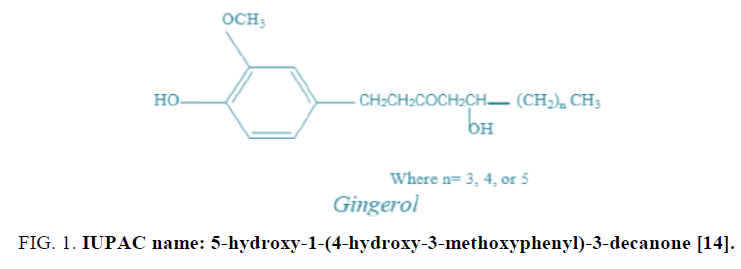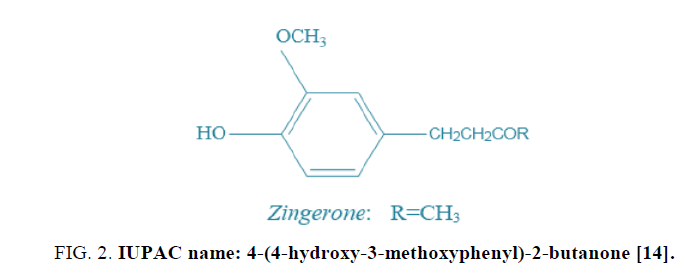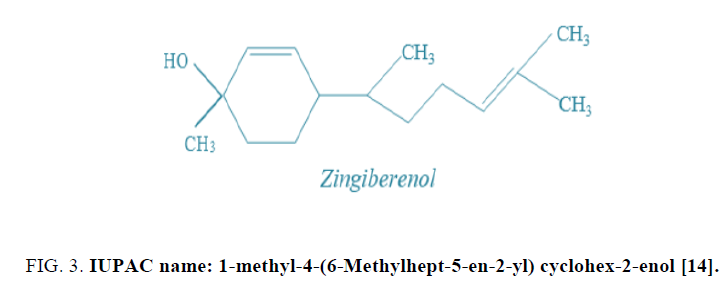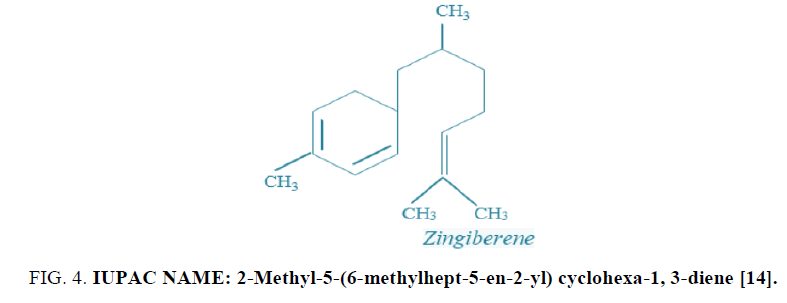Short communication
, Volume: 15( 1) DOI: 10.37532/0974-7508.2019.15(1).125A Mini-Review on the Therapeutic Potential of Zingiber officinale (ginger)
- *Correspondence:
- Muhammad W, Department of Biotechnology, Quaid-i-Azam University, 45320, Islamabad, Pakistan, Tel: +923455224994; E-Mail: wali.biotech5511@gmail.com
Received: March 20, 2019; Accepted: March 31, 2019; Published: April 10, 2019
Citation: Khan M, Ullah N, Azhar M, et al. A Mini-Review on the Therapeutic Potential of Zingiber officinale (ginger). Nat Prod Ind J. 2019;15(1):125.
Abstract
Different cultures and civilizations throughout the history of the world have acknowledged the possible usage of ginger for the treatment and prevention of various diseases. Different studies associated with ginger and its extract support the potential effect in a wide range of applications. It has been thought that different essential medicinal compounds present in ginger would reduce the risk of various diseases like cardiovascular, anti-tumor, anti-diabetic and also show beneficial results against gastric problems. The ingredients available in ginger and their long term effect and exact mechanism are still unknown. So, for this purpose more extensive studies are recommended to elucidate their mechanism of action as well as their safety in the treatment of numerous diseases.
Keywords
Ginger; Medicinal; Cardiovascular; Anti-tumor; Anti-diabetic
Introduction
Medicinal plants are the “backbone” of traditional medicine, which means people in the less developed countries utilize medicinal plants on a regular basis. These medicinal plants consider as a rich resource of ingredients which can be used in drug development and synthesis. Besides that, these plants play a critical role in the development of human cultures around the whole world. The foundations of typical traditional systems of medicine for thousands of years that have been in existence have formed from plants. The plants remain to offer mankind with new medicines. Some of the beneficial properties ascribed to plants have recognized to be flawed and medicinal plant treatment is based on the experimental findings of hundreds to thousands of years. The earliest reports carved on clay tablets in cuneiform date from about 2600 BC are from Mesopotamia; among the materials that were used were oils of Commiphora species (Myrrh), Cedrus species (Cedar), Glycyrrhiza glabra (Licorice), Papaver somniferum (Poppy juice) and Cupressus sempervirens (Cypress) are still used today for the cure of diseases extending from colds and coughs to inflammation and parasitic infections [1].
Many of the countries rely on traditional medicine throughout the world as it is easily accessible from a local plant. WHO report says that more than 3.5 billion people in developing countries use the medicinal plant for their health care [2-4]. Physicians in Africa still prescribe traditional medicine to people i-e (70%-80%). Traditional medicine is available in the majority area of the world for the treatment of human and livestock diseases [5]. The misuse of antibiotics nowadays led to drug-resistant bacteria. Additionally, the growing problem of drug-resistant bacteria compels researchers to find a new alternative way for treatment of drug-resistant infections. It is believed that secondary metabolites present in plants could be used as an alternative source for drug-resistant bacteria as due to their incredible potential [6]. This mini-review highlighted the potential pharmacological effects of ginger (Zingiber officinale).
Description of Ginger
Ginger (Zingiber officinale), as a weedy and herbaceous perennial herb which mainly found in humid regions. It grows usually 2 m in height [7]. It is called different names in different part of the world e.g. Zenzero in Italian, Jeung or Sang Keong in Chinese, Aliah in Indonesia, Adrack in Urdu, Gember in Dutch, Jengibre in Spanish, Ingwar in German, Gingembre in French [8].
Ginger has about 85 species of aromatic herbs and belongs to the Zingiberaceae family [8]. Ginger is segmented specialized stem and tuberous rhizome which horizontally grow under the soil surface. The ginger plant has about 15-30 cm long leaves. The leaves die each year and a cluster of buds produces which then blooms into flowers [9]. The ginger is mainly cultivated in some countries which are tropical which commonly includes China, Haiti, Jamaica and Nigeria [10], the true ginger.
Active Ingredients of Ginger
About more than 60 constituents are present in ginger which are considered as an active compound [11]. The important ingredients which are present in this plant root are alantolucton, inulin and some essential oils [12]. The powdered rhizome contains 9% protein, 3%-8% crude fiber, 3%-6% fatty oil, 60%-70% carbohydrates, 9%-12% water, about 8% ash, and 2%-3% volatile oil [13].
Some useful compounds of ginger which carries medicinal properties include gingerols, Ingenol, gingerdiols, zingerone, paradols, and shogaol. In these all compounds, gingerols is considered as the most important due to their active pharmacological properties. Gingerols and shogaol are chemically composed of 6-, 8- and 10-structural analogs [10]. The chemical structures of some active ingredients are as under as early discussed by Sharma [14] in FIG. 1-4.
FIG. 1. IUPAC name: 5-hydroxy-1-(4-hydroxy-3-methoxyphenyl)-3-decanone [14].
FIG. 2. IUPAC name: 4-(4-hydroxy-3-methoxyphenyl)-2-butanone [14].
FIG. 3. IUPAC name: 1-methyl-4-(6-Methylhept-5-en-2-yl) cyclohex-2-enol [14].
FIG. 4. IUPAC NAME: 2-Methyl-5-(6-methylhept-5-en-2-yl) cyclohexa-1, 3-diene [14].
Pharmacological Potential
The most important pharmacological properties of Zingiber officinale (ginger) are given below:
Positive effects on the cardiovascular system
Fluid movement including blood has been substantially enhanced owing to the usage of ginger. As it has a positive impact on heart muscle resulting in dilation of blood vessels. According to a Japanese survey revealed that the potent components of ginger remarkably lowers the cardiac workload as well as reduces the blood pressure [12]. Similarly, the platelet accumulation has been inhibited followed by platelet thromboxane synthesis In vitro. As a result, the clotting property of blood is reduced because of a reduction in the formation of thromboxane and pro-inflammatory prostaglandins [13,15]. Furthermore, cholesterol levels can also be suppressed due to ginger [13].
Effects of ginger against tumor
Firstly, like all, we know that tumor suppressor genes or anti-oncogenes play a pivotal role in the protection cells from causing on the path to cancer. Therefore, these genes need to be higher in normal active form for normal physiological functions in order to counter tumor development. Secondly, apoptosis, a fundamental characteristic of programmed cell death is also a very important body defense mechanism to destroy tumor affected cells. Thirdly, tumor progression and development is directly controlled by angiogenic factors such as VEGF (Vascular Endothelial Growth Factor) and FGF (fibroblast growth factor). So, these all factors have to be intrinsically in active form in order to control cancer’s development. In these mechanistic pathways, the compounds present ginger play a very productive role [16]. For instance, the active component 6-gingerol causes substantial function in suppression of hyperproliferation along with inflammation that leads to angiogenesis, carcinogenesis followed by metastasis [17,18].
The anti-diabetic potential of ginger
Antihyperglycemic effect has been strongly influenced owing to ginger and its constituents. It was further confirmed through animal model studies that ginger and its extracts have a momentous effect in reducing the blood glucose levels in both diabetic and non-diabetic groups [19,20]. However, the exact mechanism of action that how ginger controls the hyperglycemic effect is yet to be understood deeply. Here it is has been proposed that ginger may play an inhibition of oxidative stress as well as the anti-inflammatory process [18]. Besides this ginger also retards the activity of intestinal glycosidase along with amylase that ultimately decreases the glucose absorption inside the cells [21].
Ginger as an anti-inflammatory and analgesic agent
Prostaglandin production is substantially been repressed by slowing the action of cyclooxygenase-1 and cyclooxygenase-2. Owing to this ginger have a more therapeutic effect than NSAID (Non-Steroidal Anti Inflammatory Drugs) and less toxic in nature [22]. Additionally, the anti-inflammatory properties of ginger seem to help relieve pain and improve the function of all types of arthritis. In this regard, the medicinal compounds present in ginger like gingerol and shogaol, well-known phytochemicals along with triptan have been observed to relieve pain being caused by rheumatoid arthritis and osteoarthritis within two hours. Nonetheless, extensive studies are required to understand the mechanism behind the action of ginger in order to prevent and treat pain being caused by chronic inflammatory diseases [22]. As NSAIDs are inhibitors for Cyclooxygenase (COX), a family of isoforms (COX1 and COX2) during inflammation process, the medicinal ingredients of ginger also seems to be effective tackling the inflammation process, that are likely to be more potent than aspirin effects [23].
Effect of ginger as a gastroprotective agent
It has been observed that ginger is very potent against the treatment of ulcer both in horses as well in humans. Besides, it also enhances mucin production and enhances the synthesis of inflammatory cytokines, leading to a high inflammatory response [24]. Ginger also acts as cimetidine for treating ulcer [25]. It also repairs the stomach lining. But it does not have a direct influence on controlling inflammation as well as secretion prostaglandins secretion E2 (PGE2) content. Additionally, the constituents of ginger along with gingerol and shogaol have significant effect to increase the relative efficacy of digestion, absorption followed by constipation and flatulence in the digestive tract [23].
Conclusion
Ginger has the potency to treat a wide range of diseases. The compounds present in ginger like gingerols, shogaol, and paradols are the valuable ingredients which can prevent various cancers, induction of apoptosis, angiogenesis and metastasis and inhibition of cell-cycle progression. Beside that ginger ingredients also play a vital role to combat against diseases like cardiovascular, anti-diabetic and gastric problems. Antimicrobial and anti-inflammatory potential of ginger is also well documented in various studies. Overall, ginger is one of the most conventional medicinal herbs which improve health issues with great beneficial effect. This review concludes to favor ginger but some ambiguities necessitate further research before claiming its efficacy.
Acknowledgment
We are thankful to our parents for their motivation and financial support.
Conflict of Interest
There is no potential conflict of interest in authors regarding the publication of this paper.
References
- Hoareau L, DaSilva EJ. Medicinal plants: A re-emerging health aid. Electronic J Biotechnol. 1999;2(2):3-4.
- Seifu T, Asres K, Gebre-Mariam T. Ethnobotanical and ethnopharmaceutical studies on medicinal plants of Chifra district, Afar region, northeastern Ethiopia. Ethiopian Pharm J. 2006;24(1):41-58.
- Bekele G, Reddy PR. Ethnobotanical study of medicinal plants used to treat human ailments by Guji oromo tribes in Abaya district, borana, oromia, ethiopia. Univer J Plant Sci. 2015;3(1):1-8.
- Cunningham A. African medicinal plants, united nations educational. Scientific and cultural organization, Paris, France. 1993.
- Meragiaw M. Wild useful plants with emphasis on traditional use of medicinal and edible plants by the people of Aba’ala, north-eastern Ethiopia. J Med Plant Herb Ther Res. 2016;4:1-16.
- Sibanda T, Okoh A. In vitro evaluation of the interactions between acetone extracts of garcinia kola seeds and some antibiotics. African J Biotechnol. 2008;7:11.
- Teimoory H, Azizi M, Najafi MF, et al. Antibacterial activity of Myrtus communis L. and Zingiber officinale rose extracts against some gram positive pathogens. Res Opin Anim Vet Sci. 2013;3(12):478-81.
- Ravindran P, Babu KN. Ginger: The genus Zingiber. CRC press. 2016.
- White B. Ginger: an overview. Am Fam Physician. 2007;75(11):1689-91.
- Semwal RB, Semwal DK, Combrinck S, et al. Gingerols and shogaols: important nutraceutical principles from Ginger. Phytochemistry. 2015;117:554-68.
- Ahmad B, Rehman MU, Amin I, et al. A review on pharmacological properties of zingerone (4-(4-hydroxy-3-methoxyphenyl)-2-butanone). Sci World J. 2015.
- Al-Amin ZM, Thomson M, Al-Qattan KK, et al. Anti-diabetic and hypolipidaemic properties of ginger (Zingiber officinale) in streptozotocin-induced diabetic rats. British J Nutri. 2006;96(4):660-66.
- Zadeh JB, Kor NM. Physiological and pharmaceutical effects of ginger (Zingiber officinale roscoe) as a valuable medicinal plant. Eur J Exp Bio. 2014;4(1):87-90.
- Sharma Y. Ginger (Zingiber officinale)-an elixir of life a review. Pharma Innov. 2017;6(11, Part A):22.
- Mbaveng A, Kuete V. Zingiber officinale, medicinal spices and vegetables from Africa. Elsevier, 2017.
- Kim EC, Min JK, Kim TY, et al. Gingerol, a pungent ingredient of ginger, inhibits angiogenesis In vitro and In vivo. Biochem Biophys Res Commun. 2005;335(2):300-08.
- Lee HS, Seo EY, Kang NE, et al. Gingerol inhibits metastasis of mda-mb-231 human breast cancer cells. J Nutr Biochem. 2008;19(5):313-19.
- Rahmani AH. Active ingredients of ginger as potential candidates in the prevention and treatment of diseases via modulation of biological activities. Int J Physiol Pathophysiol Pharmacol. 2014;6(2):125.
- Sharma M, Shukla S. Hypoglycaemic effect of ginger. J Res Ind Yoga Homeop. 1977;12:127-30.
- Ahmed R, Sharma S. Biochemical studies on combined effects of garlic (Allium sativum linn) and ginger (Zingiber officinale rosc) in albino rats. Ind J Exp Biol. 1997;35(8):841-43.
- Aryaeian N, Tavakkoli H. Ginger and its effects on inflammatory diseases. Adv Food Technol Nutr Sci Open J. 2015;1(4):97-101.
- Yadav S, Sharma P, Alam M. Ginger medicinal uses and benefits. Eur J Pharm Med Res. 2016;3(7):127-35.
- Banerjee S, Mullick H, Banerjee J, et al. Zingiber officinale: A natural gold. Int J Pharm Bio-Sci. 2011;2: 283-94.
- Wang Z, Hasegawa J, Wang X, et al. Protective effects of ginger against aspirin-induced gastric ulcers in rats. Yonago Acta Medica. 2011;54(1):11.
- Singh PK, Kaur IP. Development and evaluation of a gastro-retentive delivery system for the improved antiulcer activity of ginger extract (Zingiber officinale). J Drug Target. 2011;19(9):741-51.





